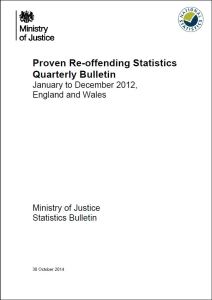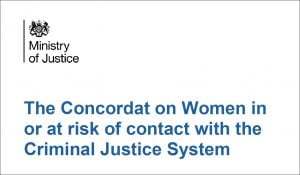Last month (30th October 2014) the MoJ published the latest reoffending statistics for both adult and juvenile offenders, including both those released from custody, and those who received a community sentence between January and December 2012.
The figures aren’t published until almost two years later because a re-offence is defined as any offence committed in a one year follow-up period from either release from prison or the making of a non-custodial sentence plus a further six month waiting period to allow the offence to be proven in court and officially recorded.
[divider]
The findings
The headline findings from the analysis show that  overall a lower proportion of adults (24.9% v 25.4%) and juveniles (35.7% v 35.9%) re-offended compared to the previous year. Interestingly, adult men (27.7%) are almost half as likely again as adult women (18.5%) to reoffend.
overall a lower proportion of adults (24.9% v 25.4%) and juveniles (35.7% v 35.9%) re-offended compared to the previous year. Interestingly, adult men (27.7%) are almost half as likely again as adult women (18.5%) to reoffend.
However, those who did re-offend, committed slightly more offences each, an average of 2.97 (up from 2.92) for adults and 2.95 (up from 2.89) for juveniles.
The overall proven re-offending rate is 26.0%, the lowest level in over 10 years. This represents a small drop of 0.7 percentage points compared to the previous 12 months and a fall of 2.9 percentage points since 2002. Since 2002, the overall proven re-offending rate for adult and juvenile offenders has remained fairly stable, fluctuating between around 26% and 29%.
[divider]
Released prisoners
The re-offending rate for adult offenders released from custody was 45.2%, the lowest level since 2002 when the re-offending rate was 7.4 percentage points higher, and a fall of 1.2 percentage points compared to the previous 12 months.
As usual, short term prisoners (serving less than 12 months) were much more likely to re-offend than those serving longer sentences – 57.6% compared to 34.2%.
[divider]
Community sentences
The re-offending rate for adult offenders starting a court order was 33.5%, also the lowest level since 2002 when the re-offending rate was 6.3 percentage points higher, this is a drop of 0.9 percentage points compared to the previous 12 months.
[divider]
Performance by Probation Trust area
Re-offending rates varied considerably between probation trusts from 27.1% to 42.9%. A large part of this variability reflects the mix of offenders who are given a court order and, therefore, it’s not fair to compare trusts on these raw re-offending rates.
However, the MoJ does calculate an adjusted proven re-offending rate to control for these differences.
Twelve probation trusts showed significantly lower proven re-offending rates than expected:
Cambridgeshire and Peterborough, Cumbria, Devon and Cornwall, Essex, Gloucestershire, London, Northamptonshire, Staffordshire and West Midlands, Thames Valley, Warwickshire, West Yorkshire, and York and North Yorkshire.
No probation trust showed significantly higher proven re-offending rates than expected.
If this level of performance is found to continue into 2013 & 2014, the new TR providers will face a substantial challenge to cut reoffending rates.









One Response
It is good to see that Probation services, whilst held in the Public Sector, have been effective in doing the task set for them – reducing reoffending. Such a reduction in reoffending rates also means lowered risk to the public. What I still find hard to understand is why this current government is insistent that this work could be done better in the private sector when there have been no tests and no evidence that this will be the case. Certainly the reoffending rates in the US, that bastion of private sector prisons and, even, probation work, do not show the reductions that the Public Sector Probation services in the UK have managed, based on the information of recidivism released by the Bureau of Justice Studies in 2014 about rates between 2005 and 2010. In the US they have 2/3 to 3/4 of all offenders released from prison reoffending. That’s massive. What is the Minister of Justice’s incentive to try to emulate this record?